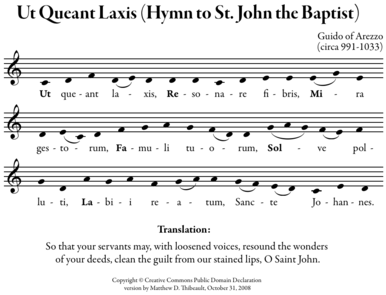https://en.wikipedia.org/wiki/Solfège
In
music, solfège (
UK:
/ˈsɒlfɛʒ/,
[1] US:
/sɒlˈfɛʒ/; French:
[sɔlfɛʒ]) or solfeggio (
/sɒlˈfɛdʒioʊ/; Italian:
[solˈfeddʒo]), also called sol-fa, solfa, solfeo, among many names, is a
music education method used to teach
aural skills,
pitch and
sight-reading of
Western music. Solfège is a form of
solmization, though the two terms are sometimes used interchangeably.
Syllables are assigned to the notes of the
scale and
enable the musician to audiate, or mentally hear, the pitches of a piece of music being seen for the first time and then to sing them aloud. Through the
Renaissance (and much later in some
shapenote publications) various interlocking 4, 5 and 6-note systems were employed to cover the octave. The
tonic sol-fa method popularized the seven syllables commonly used in English-speaking countries:
do (or
doh in
tonic sol-fa),
[2] re,
mi,
fa,
so(l),
la, and
ti (or
si), see
below.
In eleventh-century
Italy, the music theorist
Guido of Arezzo invented a notational system that named the six notes of the
hexachord after the first syllable of each line of the Latin
hymn Ut queant laxis, the "Hymn to St. John the Baptist", yielding
ut, re, mi, fa, sol, la.
[7][8] Each successive line of this hymn begins on the next
scale degree, so each note's name was the syllable sung at that pitch in this hymn.

Sheet music for
Ut queant laxis
Ut queant laxīs resonāre fībrīs
Mīra gestōrum famulī tuōrum,
Solve pollūtī labiī reātum,
Sancte Iōhannēs.
The words were written by
Paulus Diaconus in the 8th century. They translate as:
So that your servants may, with loosened voices,
Resound the wonders of your deeds,
Clean the guilt from our stained lips,
O St. John.
"Ut" was changed in the 1600s in Italy to the
open syllable Do,
[8] at the suggestion of the musicologist
Giovanni Battista Doni (based on the first syllable of his surname), and Si (from the initials for "Sancte Iohannes") was added to complete the diatonic scale. In
Anglophone countries, "si" was changed to "ti" by
Sarah Glover in the nineteenth century so that every syllable might
begin with a different letter.
[9]"Ti" is used in
tonic sol-fa (and in the famed American show tune "
Do-Re-Mi").
An alternative theory argues that the solfège syllables (
do, re, mi, fa, sol, la, ti) derive from the syllables of an
Arabic solmization system درر مفصّلات
Durar Mufaṣṣalāt ("Detailed Pearls") (
dāl, rā', mīm, fā', ṣād, lām, tā'), mentioned in the works of
Francisci a Mesgnien Meninski in 1680 and later discussed by
Jean-Benjamin de La Borde in 1780.
[10][11][12][13] However, there is no documentary evidence for this theory.
[14]

